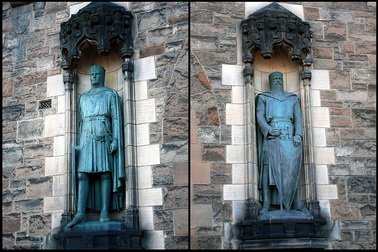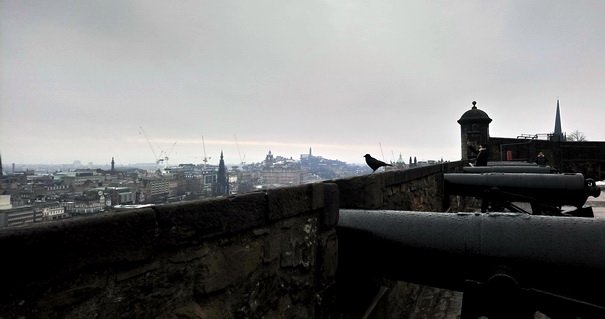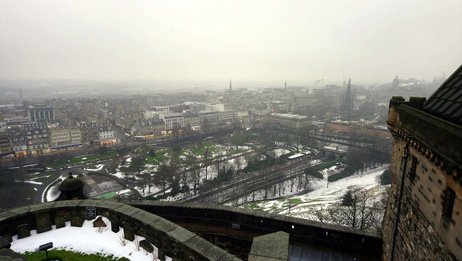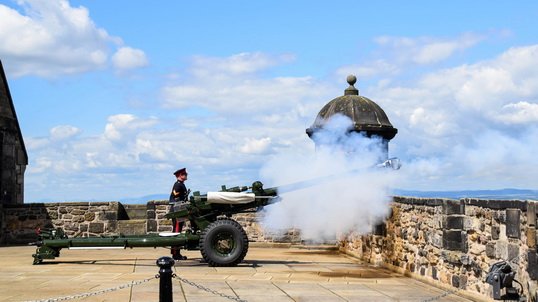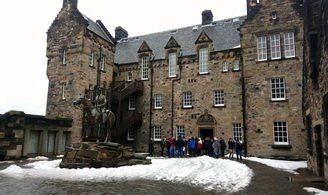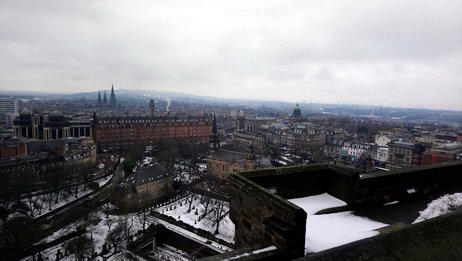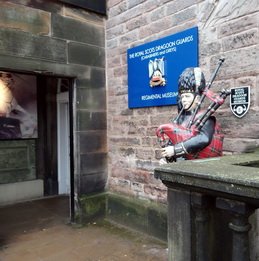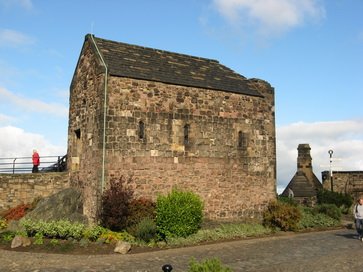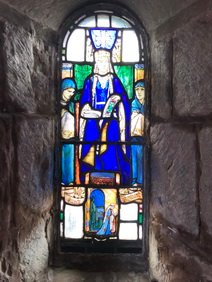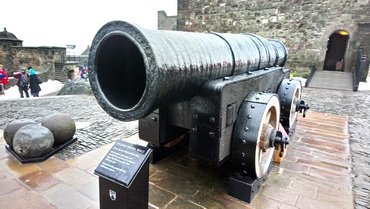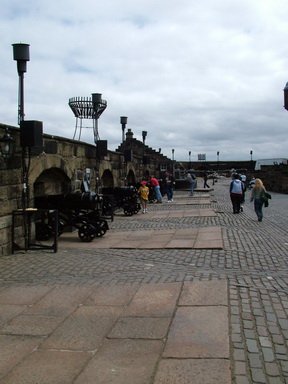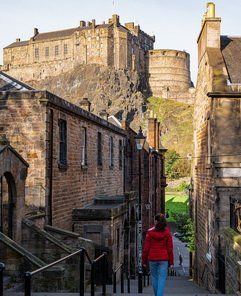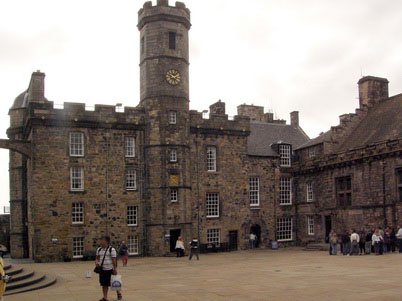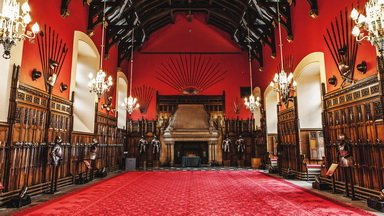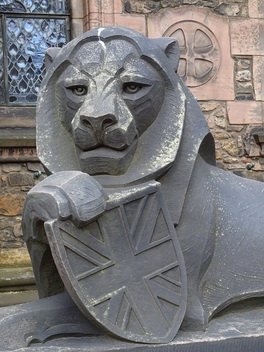Edinburgh Castle Walk
Points of interest
1 Castle Esplanade and the entrance – 2 Between the gates – 3 Long Stairs and Constable Tower – 4 Argyll Battery – 5 One O’Clock Gun – 6 National War Museum and Butts Battery – 7 Going up – 8 Governor’s House and the Barracks – 9 Dungeons and Drury Battery – 10 Foggy Gate – 11 St. Margaret Chapel – 12 Mons Meg – 13 Half Moon Battery – 14 David’s Tower – 15 The Crown Square – 16 The Palace and Great Hall – 17 National War Monument

C
astle of Edinburgh
Situated on its high perch of Castle Rock, it is a must-see as they say. Every year over a 1.5 million people visit it. Alas – castles are Scotland’s greatest treasure – you should at least visit one.
This one will tell you the story of Scotland – being THE ROYAL CASTLE it lived through it all. It was a gateway to the North – who had it, controlled the region. Its walls were mutilated by sieges. This is why today each part of them can tell you a different story. One of bloodshed, one of courage and mountain climbing, one of mischief and brilliance, comedies and tragedies. You have it all in here. There are museums inside, mostly military – but the place itself is a museum with its dungeons, chapels and palace. What is the most important – there are Crown Jewels there – once lost and now on display. Maybe this place will inspire you like it once did with Rowling or G.R.R.Martin. You never know, but you can be sure you will be entertained there.
The Castle offers different means to visit it – you have a brochure or a free guided tour that lasts 30 minutes. It shows you the layout, tells you a few stories and you are left alone to see the rest on yourself. You can buy a souvenir book – there you will have a bit more information about everything. Or you can buy an audio-guide which is the most detailed – personally, I listened to everything and spent 4 hours in the castle (being a history geek and all).
You can go inside with a tour or take those few pages with you (download here). I won’t be entering to the museums with you but I will tell you what you can expect to find them. Only wandering around you can see a lot and I will try to spice it with a story or two. It will make those old walls more alive I hope. The Walk should take you about 60-90 minutes. It finishes at the top, at the Crown Square – from where you can go down entering the various museums – if you choose to do in this way.
I strongly recommend visiting the castle in the morning or after 3 PM. Crowds are much smaller then. The worst is between noon and 2 PM because of a thing happening in the castle. And, of course, the biggest crowds are between May/June up until September/October-ish. Later there is the wind, the cold and the haar so you would have the place to yourself.
Enjoy!
1 Castle Esplanade and the entrance
Standing in front of the castle’s first gate.
The view at the castle is impressive no matter where you stand. This towering colossus has been standing on this rock since the times of the first, wooden fortress of Celts. They chose this site of an ancient volcano because of its strategic meaning. Although the first clues about a civilization here come from around 3000 BC, what we can see today is a mosaic of the last 500 years. The esplanade was added in XVIII century for the military parades (like the Military Tattoo of nowadays). Even this wonderful gatehouse in front of you is a late product od XIX century. The first entrance was more to the right (if you follow the wall with your eyes).
But now we have a baronial style, romantic addition that flamed the souls of the Englishmen coming to visit in the past. The moat is dry, but it allows a drawbridge to be there. The king’s symbol – red lion on a yellowish background is there, reminding whom the castle belongs to. Imagine those colors inversed – do they remind you of something? I will leave it for now, but keep it in mind…
Two XX century, yet old, guardians watch as you enter. Robert de Bruce is shown with a crown. It was he who received this honor after the Wars of Independence 1296-1328. All because the nobles couldn’t decide on a king and asked Edward I Hammer for the Scots for help. They should have known… the English king used this occasion to take control of Scotland. But being like the unicorn impossible to enslave, the Scots fought and created the legends of that time.
It was not his neighbor – William Wallace, that is supposed to be the true Braveheart. A legend says that after many defeats Bruce hid himself on an island. There one day, he saw a spider trying to build his web over and over again. He did it anyway and Robert saw a prophecy in it – like the spider he had to experience defeat to finally build his victory. He returned to the battlefront and in a battle of Bannockburn in 1314 defeated the Englishmen.
William Wallace is the one that received the honors of a movie. He fought in the same wars, with the king and alone. He had his famous victory at Stirling Bridge, but was eventually captured by the enemy. Then he suffered tortures and a spectacular public execution. To the Englishmen he was a monster, to the Scots he was a hero.
You decide who is the Braveheart and go inside to buy some tickets.
Entering through the gate you have the toilets on the left (free). You need to go right to the ticket office (unless you have it from somewhere else or you have Explorer Pass). Without the ticket you can also go to the souvenir shop – the ancient fire platform. Eventually you will move up to the second gate – they will check your right to follow that path there.
2 Between the gates
The ancient people of Goddodin called this place Dunedin – the Din (city) of Eidyn. With the coming of the Anglo-Saxons and their language, it became the burgh of Eidyn or rather Eidyn-burgh. At that time it was only a settlement at the top of the Rock – where the whole village was situated.
This road that we walk now was added many years later. It passed over a moat, under the watchful eyes of the guardians. Then you came to the gate, where you were throughoutly searched. Do you feel yourself braving this castle? In this throat like passage – between the guns and a wall?
Wood turned to stone, and stone to a castle. Not any other castle – it was a gateway to the North. Because of this it was besieged 26 times! Although the most memorable ones will be told during the Walk.
Now the “mosaic of time” is understandable. The next gate – Portcullis Gate is from XVI century. It was after yet another war, this time the Long Siege, that it was put here. It had 4 barriers – a gate and 3 doors – you can still see the hinges when you go through. The topmost part was added later – being called the Argyll Tower. This is because Archibald Campbell, 9 Earl of Argyll was a prisoner here before his execution. He was a loyal subject to the crown in XVII century, but became too powerful in the view of others. They accused him of treason. A story like many others…
As you pass through the gate note its insides, the hinges of the doors and the reliefs. On the other side you will have a booth with audio-guides to the right. A bit further, behind it there is a clock on the wall – the point to meet the castle tour-guide. To the left you will see the stairs. Straight – there are some canons and the views. Go in that direction a few meters so that you can fully take the view of the Argyll Tower – which is even more beautiful and detailed from this side.
3 Long Stairs and the Constable Tower
Here you can finally see that there is more to the Castle than it looks from the outside!
Edinburg became a royal burgh in XII century during the reign of king David I (Dunkeld Dynasty). It is sure the castle was already made from stone then, but the true road to the top led through the stairs that you see to the left. They are called the Long Stairs and have around 70 steep steps. They pass next to the ruins of a Constable Tower on the right. It could have been a guard tower of the Upper Ward… Maybe you notice a sign on it, with a date of 1313 written there.
Look up, because it is above your head, on the wall of the tower. You need to go further away from the stairs, if you cannot see it.
For a long time the castle wasn’t permanently inhabited by the king. This was because of many wars that took place in this part of the country – two neighbors always pushing North or South… The worst came after the reign of king Alexander III. On one stormy night the king decided that he needs to visit his wife. He mounted his horse and went to Fife, but the night was dark, and he fell. His death was followed by the reign of his child daughter and later by the quarrel of the nobles. Not being able whom to choose the aristocrats asked the king of England for help. Edward I wasn’t called the “Hammer of the Scots”… yet. He came to the rescue, all the time wanting to acquire the power for himself. He proposed Balliol line instead of de Bruce line – both lines deriving from king David I. But Balliol was a puppet and the unrest followed with some English presence in Scotland. This time is known today as the Wars of Independence.
You already met two of its heroes at the first gate. Their brilliance being the strategy where they used the terrain to their advantage. It is sometimes called a guerilla war and I compare it to Partisans’ fights in Poland. Both opposed much larger forces. Even “the final” open field battle was carefully planned – it made Bannockburn (June 1314) a true masterpiece.
Part of Bruce’s strategy was the destruction of castles, so they couldn’t be used by the enemy. Edinburgh was one of them. It was Thomas Randolph who in the middle of the night, with only a few brave men, climbed the cliffs. They did the impossible and surprised everyone inside. It was March 1314 and it partly made Englishmen go to Stirling where they faced the future king.
On the Plaque you see another date – 1313 and it is not a mistake. It is because of the Julian calendar who was still valid when this sign was put there. New Year came in March there before it was change to Gregorian calendar.
Reassuming – the Wars ended with the victory of the Scots, signing the first declaration of independence in Arbroath (although it wasn’t taken into consideration by the Pope), crowning of Robert de Bruce and a period of relative stability in Scotland. The castle was rebuilt only to be destroyed yet again later…
Now you can explore the canons.
4 Argyll Battery and the North view
And so it went – once the castle belonged to the Englishmen, another time to the Scots. Another great story comes also from the XIV century – when a group of soldiers, disguised as merchants, recaptured the castle from the English hands. This time the group was led by Sir William Douglas. The wars were caused by Edward III who wanted to go in his grandfather’s footsteps.
Years later this road that we walk on was built. It was the time of Stuarts already, and the kings were in love with the new war toys – the canons. The road was needed to transport them to the castle walls. But the Argyll Battery that you approach is the product of yet another siege – the one belonging to a Jacobite Rising of XVIII century.
It is named after Prince of Argyll who battled the Christian rebels in the name of the protestant king George I from the Hanoverian line (Stuarts married into other dynasties). It was built by George Wade who also laid roads and bridges through the Highlands. The canons that you can see come from Napoleonian period.
But THE canon that you want to see is a little further away, looking very contemporary. Before you go to see it closer take in the North view. You have a rare occasion here to see the New Town of Edinburgh from above.
Right underneath the Castle there are Princes Street Gardens. To the right you see two Greek temples – the art galleries. The road dividing the gardens is called the Mound. In the second green area you see the black spire of the Scott Monument. Go further – there is the Balmoral Hotel with a clocktower, North Bridge and Calton Hill. The street running parallel to the gardens is called Princes Street – it is the beginning of the New Town of XVIII century. You can see the straight lines of the plan of James Craig. How different must it have been from the cozy Old Town! Further to the north there is Leith – the port of the Firth of Forth. The land beyond is the Kingdom of Fife – the granary of the ancient Scotland. (more in the New Town Walk)
5 One O’Clock Gun
What you see is a 105 mm field gun. But the first One o’Clock gun was a 64-pounder which was standing at the Half Moon Battery! Why did it receive this name? It is because of a custom that was brought to Edinburgh by a businessman John Hewitt. While visiting Paris in 1861 he observed how a gun was fired at noon. He terribly liked it and made everything in his power so that the same would be happening in his city.
Edinburgh already had its own, less noisy tradition. Around 1 PM every day a ball was elevated at the top mast of the Nelson Monument at Calton Hill. At a precise time, it was dropped. This visual signal was important for the fleet stationed in the Firth of Forth. They adjusted their instruments in this way. But the city is known for its dense fog – haar that sometimes made it impossible to see the ball. Hewitt’s idea was an addition to the original custom – therefore it is One O’Clock gun and not a noon gun.
The gun was operated by a famous Shannon the Cannon (Seargeant James Shannon) since 2006. Sadly, he died in December 2018. He was loved by his comrades. Obviously also by the tourists that gave him this nickname. The Gun will never be the same.
You can see the story and the technology behind the cannon under it. There are stairs leading down that show you into a room telling you the full story. If you want to see the spectacle of firing the gun be sure to come earlier because the crowd will be dense. The best view is from the terrace close to Margaret Chapel, further up.
From the One O’Clock Gun you won’t be going up – this will come in a few moments. Next to the restaurant (a former Carriage House) – there is a small street leading down. Go there.
6 Butts Battery, the West view, and the National War Museum
As you go down to the small square you can see a statue on a horse that greets you. It is looking to the West – to the stairs where you can go up and profit from the views. There are also two doors leading to the buildings on your left and right. The true entrance is on your left-hand side and it will lead you to a museum.
The buildings you see around you served different purposes throughout the centuries. They were mostly warehouses, workshops and houses of various people living and working in the Castle.
After being a hospital for a while they were eventually turned into a museum dedicated to the wars of Scotland. Inside you will find the arts and crafts of war starting with a highland sword and finishing with a gas mask. There is also a painting of the famous Thin Red Line (by Robert Gibb).
You can say that the horse statue is also a part of a war museum. This is the Field Marshal Douglas Haig and he was once adorning the Castle Esplanade. More sarcastic voices tell us that nobody wanted to look at the killer of Scottish and English soldiers and so he ended in a backyard. After the Battle of Somme during the First World War many died because of his decisions. In the memory of it he was even nicknamed “The Butcher of Somme”.
Leave him for a more cheerful sight – the views to the West of Edinburgh – mostly to the West End and Fountainbridge. The large cupola could be the dome of the Usher Hall (concert hall) – named after the inventor of blended whisky. If you look straight down, you will see more lines of the walls. You could have visited them once, but due to the bad weather they were closed. Reports of accidents and fallings have been reported since XVII century.
But this nuisance made it perfect spot for secret meetings! In 1689, at Sallyport (gate to make sallies at the enemy unnoticed) down there, two people met. George Gordon was the commander of castle forces and John Graham was commander in field later known as Bonnie Dundee. They were both loyal to the Stuarts, just overthrown by William of Orange and Queen Anne Stuart. They lost but the gate was used again in the second Jacobite rising (middle XVIII c.). Another group of soldiers braved the Rock and tried to enter through this hidden passage. Their plan was to use a portable ladder, but they forgot one element of it. They then used the ropes, but they were spotted, the lines were cut, and they fell (you can see a small entering on a the 2nd photo from point 8).
Sometimes the best-laid plans… (quote from Robert Burns To the Mouse)
7 Going up
Exit the Battery and return to the restaurant. You can now start to go up but do it slowly. As you elevate the views to the North change and captivate with small differences for you to spot.
From the numerous disasters that the Castle faced the next, big siege was the worst. It was called the Lang Siege (long) and happened in XVI century. Even the sieges of the Jackobites weren’t that bad. And the World Wars did nothing to those walls. Yes – the zeppelins were dropping bombs on the city but they thankfully missed this spot – going down on Grassmarket. Plus – they were more interested with the shipyards in Clyde near Glasgow.
XVI century is the beginning of Reformation in Scotland and the religious wars that lasted for almost 200 years. Why that long? The Jacobite rising was political, but it was the fight to preserve a Protestant king instead of a Christian one.
It all started with a lack of male heir to James V. His rival in the South – Henry VIII, imagined that the daughter Mary would be the perfect bride for his son. That is how the “bloody wooing” started and that is how Mary had to flee to France. She lived there for a long time, even married the heir to the French throne. But the boy died, she was not welcome anymore and she mixed herself in politic that she didn’t understand. She returned to Edinburgh in 1566 – a woman, a catholic, more French than Scottish. She didn’t even remember the language!
She was met with animosity from John Knox expanding the reformation and the nobles. Maybe she married Henry Stuart Darnley to blend in a little. What is important is that they had a male child. And that was the end for her. The nobles preferred a child that could be molded to his mother. She – fled, fought and eventually hid herself in England (only to be decapitated there).
One of the battles of those times is of a siege of this castle. Her supporter William Kirkaldy of Grange was holding it. He fought long and surrendered only after the nobles brought the English canons. The castle was in ruins, a handful of soldiers surrendered, and William was hanged in front of St. Giles.
The long siege made the creation of Half Moon Battery and Lower Ward Possible. Even Cromwell – who was occupying the castle next didn’t do much damage. It was XVII century and he only made a few changes to house his garrison. Bu that was already a time when the castle was abandoned by kings and housed mostly soldiers.
Turn around and go up – notice a building to the right under the shadow of the tree. The façade continues until it arrives to an enormous building with 3 floors. There is a small leveled place there where you can catch your breath. From this point you should also see one road going down between the buildings and another going up to yet another gate.
8 Governor’s House and the Barracks
As you go up you pass a row of stone buildings on your right. One of them has a special entrance… more significant – with a triangle tympanum above the door.
This is the Governor’s House (8a). In XVIII century the person responsible for the castle received its own lodgings. The post of a governor was abolished for a short period, but it returned in the middle of XX century. It is more symbolic and representative right now.
Before the governor was there to give orders to the garrison stationed in the castle. The soldiers received their own quarters in XVII century. This is the last building in the row as you go up – the one with 3 floors (8b). At one of its entrances there is a statue of a Scottish soldier. This place once held 600 men! It may look small, but from the side of the cliff you will see that there are 3 more floors going down.
Today it is divided between the residing Royal Regiment of Scotland that takes care of the Castle and the museum. The entrance to the latter is where the soldier’s statue is. It I dedicated to the Royal Scots Dragon Guard.
The second regimental museum (8c) can be seen when you turn around. It is the small building in the corner of the roads. This one is the Royal Scots Museum. They both give a complete picture of the army in Scotland. The first one was created by king Charles I in 1633 to fight in the French wars (30-year War with England). They returned to their country in the reign of the next king. Charles II created also The Royal Dragoons that turned into the famous Royal Scots Grey.
Scottish soldiers were known through ages for their bravery and fierceness. This may be their Highland blood’s fault. They captured the eagle in the battle of Waterloo. It was Ewart Ensign who has a grave on the promenade now. And the eagle you can see in the Dragon Guard Museum. As well as the mementos of the soldiers of the Thin Red Line (in both museums). The British troops fired at Russian cavalry saving the day then. In their memory the local regiment is named after the battle of 1854 – Balaclava Company. There are also stories from various fronts in the Royal Scots Museum – of battles commanded by Wellington and Churchill. Napoleonian wars, African wars or the First World War that took the life of 11000 Scots.
You may now choose what to do – visit museums, go up or go down. I recommend taking the road down – it will lead you to a “hidden” square. It relates to the wars so we can just continue with the story.
9 Dury Battery, the prisons and the dungeons
At the end of the road you find yourself on another firing platform. To the right there is an entrance to the prisons, and to the left – to the dungeons.
The XIX century prisons were put there for the local garrison. The soldiers there were mostly drunk on duty. Today they are a reminder to show us how a military holding place looks like. I personally love the bathroom!
Dury Battery has more to offer. Approach the small windows looking out at the city. The view is terrible, but you can see some doodles on the walls there. Some of them, like the ships – strike with details… The place was a fire station, but imagine a gate once existing at its entrance. The space that you are in was actually a prison yard in XVIII century.
This time the inmates were held in the dungeons – you will find them at the second door here. There are hammocks and straw and stale bread. They are only missing the rats. They once housed numerous prisoners – mostly sailors captured in the wars of XVIII century. It was a time of many conflicts, partly because of the American War of Independence. England was in war with everyone and so the dungeons were full of pirates, privateers, sailors and soldiers.
Having nothing to do, they scribbled on anything – doors, bones, walls. Or they built small things – like chests or wonderful, ship models. You can see them in a small museum inside on of the cells. They sold those things to the town people – a simple exchange through the bars of the gate.
You may not find a Jack Sparrow in here, but you can find sailors working under John Paul Jones – the father of the American Navy. You can find forgeries of the local currency of that time – people here were really bored and ingenious. They even tried to break out multiple times. One story is of a man hiding in a barrel of wastes – it is a pity that he didn’t know that the garbage is thrown off the Rock. On the other hand, the escape of 1811 is still visible – through a hole in a wall that gave freedom to a group of men.
With the taste of the fantasies of wars and pirates you can now go up and then up again through the last gate on your path.
10 Foggy gate
It should really be the “foog” gate or “haar” gate. All with the indication to a fog covering Edinburgh sometimes. The one coming from the sea is the most dense, cold and humid – a reason for many to stay in bed.
Let me explain the name through another story. There was not only hatred between England and Scotland. Marriages between the two have been happening for a long time. One of them was of James IV to an English princess, sister of Henry VIII – Margaret Tudor. Her husband wanted to bathe her in riches similar to the court she had left. He built her the Palace of Holyrood. But before that she lived in the Upper Ward of the Castle – it was behind this gate.
She hated in here! Mostly because it was cold, dark, gloomy and heavy – it was a place to defend in not to live in. Her main argument was that the fog comes to the doorstep of the gate, making her life unpleasant.
11 Upper Ward and St. Margaret Chapel
After crossing the gate, you have a view of the Upper Ward. Looking around you have a souvenir shop to your left. Going like a clock – there is a small stone building at an elevation – there is the St. Margaret Chapel. In front of you there is a path turning right to the batteries out there. To your right you see a huge black building looking like a church. You can get there with a second path to your right.
Can you imagine the citadel in here? In medieval times that was what was situated in the Upper Ward. You only ever got here after crossing all the previous walls, gates and soldiers. The mass of buildings to your right may call to you but focus on the building to the left first – you can get there easily with those few steps next to it.
This is the oldest building in all of Edinburgh – coming from XII century. It was built here by David I who wanted to honor his dead mother – Margaret, in this way.
Margaret is a saint and a former wife of a great king of Scotland – Malcolm III Canmore from the Dunkeld line (meaning “great” and “big head”). She did a lot of good in her lifetime, taking care of the Christian religion and its pilgrims. She even built the crossing between Edinburgh and Fife. These were the ferries first and you can follow their path each time when you cross one of the three bridges going North (e.g. Forth Bridge). In the memory of the past the village there was and is called Queensferry.
The chapel may have once been a part of a citadel – the one connected to the Constable Tower from the beginning of the walk. Today it still serves its purpose being the place where military weddings take place. Inside it is really small but charming with an altar and wonderful stained glass. It was D. Strachan who made them in XX century to represent Saint Andrew and Margaret, William Wallace, Saints Ninian and Colomba.
Next to the chapel’s entrance there is a canon and a magnificent view of the North Edinburgh. This is the place to watch One O’Clock Gun fire.
12 Mons Meg and Pet Cemetery
The first king that has fallen in love with the new art of war and its tools was James II. His wife was Marie de Guelders. Her uncle – Prince of Burgundy – Philip III gave them this wedding present.
Mons Meg takes its name from a city where it was made – Mons. It is an impressive piece of ancient war. It is so heavy that 100 men needed to transport it and it could make only 5 km per day! One cannonball weighs 150 kg! Try to look inside – you can almost put your head there.
It wasn’t used very often being problematic. It didn’t even have a century of work when it was abandoned in 1550. Meg became stationery and was used only on special occasions like the birth of James VI, coronation of his mother etc. The cannon was taken to London for a moment, after the Disarming Act of 1754 that followed the Jacobite Risings. But it returned, thanks to Sir Walter Scott, in 1829.
Another thing in here you can find when you approach the railing and look down. Try to locate a green space a bit to your right. Do you see tombstones there? I sometimes wonder if Steven King took the idea from here… This is the place where soldiers and the Regiment put their pets to rest. Some of them travelled with them to the front lines, so they deserved a proper burial.
13 Half Moon Battery
You can now walk down and follow the path to your left. It will take you close to Forewall Battery (13a), next to the castle’s well (13b) – to the round space of yet another firing station.
“Fore” or “front” wall was the side of the castle that faced the enemy and the only road that he could come with. You will get a great view to the Esplanade and the Royal Mile from here. It is not a surprise that this was the part the most fortified. Do you remember the merge of stone and wall that greeted you as you entered? These were the fundaments of this battery – built after the Long Siege in XVI century. All that was before was destroyed with the fire coming from the direction of the Mile.
The well you pass is very impressive though it looks boring. It goes down 34 meters and it enters the basalt rock of the former volcano. It can hold 11000 liters of water and was indispensable during every siege. Both attackers and defenders knew it. There were times when the defenders, on leaving the castle, poisoned a well (by throwing a dead animal in it). The enemy force that would rebuild the fortress next had a nasty surprise.
The round shape of the most recognizable part of the defenses is empty today. The Half Moon Battery was once decorated by the One O’Clock Gun and Seven Sisters. Today it is a shape that defines the castle from the distance.
Another formidable part of local history is hidden under your feet. For that you need to exit Half Moon Battery, turn left and notice the stairs. They lead down to the toilets, but there is door to the left that will give you the access to what is underneath.
14 Ruins of David’s Tower
Another king of the past – David II (from de Bruce Dynasty) built his citadel in this place in XIV century. It was a big tower – partly connected to the palace that you will see next. All was destroyed during the siege of XVI century and later the Battery was built over it. Today we can only see the basements and some rooms that look like a dungeon.
If you feel a chill this may be because of the horrible things that transpired here. In 1440 there was a dinner here. Young James II was meeting with the clan leader, also a boy – William Douglas and his brother. This was a time of formidable strength of the Black Douglases. Their leader was newly chosen and so he met the king. Unfortunately, the caretaker of the castle – William Crichton, took this opportunity to destroy the clan. At one time a bull’s head was brought to the hall and positioned in front of the Douglases. That was a signal to drag the boys out, where they were hanged. The king was too young to object.
You may recognize The Black Dinner from another place. Two brothers killed… like Ricard and Brandon Stark? A dinner turning to a bloodbath… like the Red Wedding? This is not the only inspiration for the Game of Thrones. You could say that the whole Scottish history is there. But just here… from this castle – do you remember the lion crest from the entrance. The opposite of it – the yellow lion on red background is the Lannister coat of arms!
Leave this gruesome place and return to the light. It is time to see the Crown Square.
15 The Crown Square
When you exit the stairs turn left and go through a passage there, between the buildings. You will have a door on the left – the stairs there lead up – they are of some interest. On the right, you see the National War Memorial – the pride of the Castle.
Standing in the center you may feel like in the inner courtyard. It was created here in XV century in a project of reshaping the fortress by James IV. He was a renaissance king who brought the Golden Age to Scotland, and he wanted a bigger palace and a great hall (it is also possible that he did it for his English wife).
If you face the National War Memorial, you have the palace to your right. There should be a queue there maybe? And another door to the right with a plaque with the year 1566. You can go to the Palace from this entrance or take the other door and visit the royal rooms and the place where James VI was born. But I recommend those doors that you have just passed by – you will go through the exposition telling you the story of the Crown Jewels.
Behind you is the Great Hall of James IV. And the building on your left is the Queen Anne’s building. Once a kitchen, warehouse, barracks, museum and finally – a restaurant.
16 The Palace, Jewels and the Great Hall
The Palace (16a) as you can see today is the remnant of David II’s tower. It was later renewed by James IV to match the Great Hall. The rooms inside are small, filled with portraits of the kings and memories of the past. The last king that warmed himself at its chimneys was Charles I in 1637. The place was practically abandoned when James VI became James I of England and moved the court to London.
The castle was then garrisoned by different parties thorough the years. But held a great secret which were the crown regalia hidden in a chest in a sealed room of the palace. Scottish kings received their papal approval quite late – but it came in a form of a scepter given to James IV in 1494. The sword followed a dozen of years later. A crown was already there, but it was reshaped to fit the renaissance times – it was James Mossman (owner of John Knox House) that did it in 1540. All three regalia were first used during the coronation of Mary Queen of Scots.
It is a pity that a century later they had to be firmly hidden from Cromwell. It had to be done – the king was beheaded by the very soldier, who now reigned over the country with his almost puritan, protestant armies. Regalia were hidden in Dunnottar Castle and then transported by some women in a bundle of clothes to yet another one. Their journey ends in 1707 when they were sealed. It was the year of the Union of Parliaments.
They came back to the light because of a snooping historian – Walter Scott. It earned him a title “sir” and some fame. It was thanks to him that the king came to see the regalia, Edinburgh and Scotland after over 100 years of absence. Today the Regalia are housed in a palace in the Crown Room. This is why the queue is there.
I recommend going through the side doors that I pointed before. They will take you to an exposition that will show you the story of the kings in Scotland and the regalia. At the end of the path there is the Crown Room. The queue will be there but smaller. The big one – form the square – takes you directly to see the Regalia.
An interesting part of the exposition is the Stone of Scone or the Destiny Stone. A piece of rock, but over the centuries every Scottish king was crown in Scone Abbey over it. It was stolen by Edward Longshank during the Wars of Independence in 1296. He put it under the coronation throne in Westminster, so each new king there was also, in a symbolic way, crowed the king of Scotland.
I love the story about the restealth of the Stone by the students in 1950. Don’t ask how, but they drove it from Westminster to Arbroath and, supposedly, hidden it in the field, among other rocks. The Stone returned to England finally, but was returned to Edinburgh with a great celebration a few years later.
The other door to the Palace, the one witch the plaque 1566, will show you to a room (16b). There in a corner, there is a small cell, where James VI was born (in 1566).
The entrance to the Great Hall (16c) is visible as well. Although it comes from 1511, the only original thing in it is the hammerbeam roof inside (look for the symbols of roses, thistle, fleur de lys or the initials of king James IV carved into stone). Cromwell turned it into 3 floors of barracks in the middle of XVII century. They later served for a warehouse until Hypolite Blanc restored it to its former glory. It looks old, but it comes from XIX century. Even the stained glass is made by D. Strahan (same as Margaret Chapel).
17 National War Monument
Last, but not least is the dark, imposing shape of a former church. As you look up you see people standing there – the figures are the personified virtues. A lion – a symbol of kings and a unicorn – symbol of Scotland, guard you with watchful eye as you enter. Inside you are greeted by an empty space, ledgers next to the walls and an inner chapel – closed to visitors. Only as you look up you see more symbols and allegories put into careful ornaments by R. Lorimer.
The church was eventually turned into a chapel dedicated to the soldiers fallen in the First World War. A reminder – it was 11000 people that died, but there were also 40000 wounded! Since then there were other wars that Scottish soldiers took part in. They are all memorized here. You can look up their names in the ledgers.
But the original scroll of the first battle is safely hidden under the wings of Archangel Michael. The sarcophagus you see in the center is not for a man, but for a list of names of those brave souls. Since 1927 people have been coming here to cherish their memories.
To cheer you up I will share that there is one option to enter free to the castle! With an escort of a guard you will be led right here. It is a National War Memorial after all – open to everyone. They say so, but I never tested it… I leave it to you if you dare.
The End
With this last place we made a full circle. Your time travel is over, and you are safely returned to our times. You can now wander around and explore or return to the things you liked most. Did you heed my advice and went straight for the Crown Square? I know I wouldn’t – regardless the queue at the end of the journey. The castle is just too fascinating!
You can now return through the other entrance to the Square that will lead you to Foog Gate. Or you can retrace your steps to the Forewall Battery – follow it and find the Lang Stairs leading down to the main entrance.
If you need more of the stories of this city – go to the other articles. Or forget about reading and make the stories yourself, between the people. Have fun!


